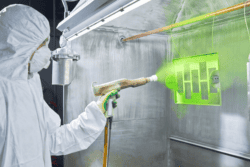Corrosion is and always has been a major issue with metals in particular, and often causes irreversible damage. Coating and plating are two techniques that are widely used to make materials more corrosion-resistant.
So, what exactly is coating?
Coating is the application of a powder or chemical to a surface or object known as the ‘substrate’. There are two main types of coating: powder coating and liquid/ceramic coating.

Powder coatings are free from solvents, durable, and offer high resistance to scratching, chipping, and general wear and tear. The only downside is that they fade when the surface is exposed to sunlight.
Ceramic coatings are created using clear liquid polymers. They are glossy in appearance and you can still see the metal through the coating. Ceramic-coated items can withstand temperatures of over 3500 degrees Fahrenheit. The main disadvantage is that this coating is considerably less durable than powder coating.
Coating leaves a finish that is stronger than paint and improves resistance to wear, chipping, corrosion, and scratching. However, hardness can be reduced and adhesion can be negatively affected.
Coating is important for both decorative and functional purposes. It is used in numerous industries, including aerospace (on landing gear), oil and gas (on pump engines, seals, and shafts), and medicine (in implants and on equipment).
What is plating?
Plating is the process of adhering a metallic finish to a conductive surface using electro-deposition. The new metal that is deposited becomes fused with the existing surface/substrate. Plating can be used for decorative or functional purposes.
The main advantages of plating are that it can be carried out on a range of high-quality metals, it offers a protective layer against corrosion, it is cost-effective, and it can provide increased strength/hardness.
A classic application of plating is in the jewellery industry, where it is used to provide a gold or silver finish. Plating is also used on car parts, aircraft components, and electrical components.

Electroless Nickel Coating
Electroless Nickel Coating offers excellent corrosion-resistance to salt water, carbon dioxide, oxygen, and hydrogen sulphide. Electroless Nickel Coating gets its name from the fact that it utilises chemical reduction instead of electrical current.
Essentially, the key difference between plating and coating is that whilst a coating simply adds a layer on top of the surface/substrate, plating fuses the new material to the original one.
